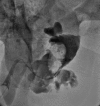Lower urinary tract injuries following blunt trauma: a review of contemporary management
- PMID: 22114545
- PMCID: PMC3222924
Lower urinary tract injuries following blunt trauma: a review of contemporary management
Abstract
Lower urinary tract trauma, although relatively uncommon in blunt trauma, can lead to significant morbidity when diagnosed late or left untreated; urologists may only encounter a handful of these injuries in their career. This article reviews the literature and reports on the management of these injuries, highlighting the issues facing clinicians in this subspecialty. Also presented is a structured review detailing the mechanisms, classification, diagnosis, management, and complications of blunt trauma to the bladder and urethra. The prognosis for bladder rupture is excellent when treated. Significant intraperitoneal rupture or involvement of the bladder neck mandates surgical repair, whereas smaller extraperitoneal lacerations may be managed with catheterization alone. With the push for management of trauma patients in larger centers, urologists in these hospitals are seeing increasing numbers of lower urinary tract injuries. Prospective analysis may be achieved in these centers to address the current lack of Level 1 evidence.
Keywords: Multiple trauma; Rupture; Urethra; Urinary bladder; Wounds; nonpenetrating.
Figures





References
-
- Djakovic N, Plas E, Martínez-Piñeiro L, et al. Guidelines on Urological Trauma. Arnem, the Netherlands: European Association of Urology: 2009. Mar, Accessed August 3, 2011.
-
- Avey G, Blackmore CC, Wessells H, et al. Radiographic and clinical predictors of bladder rupture in blunt trauma patients with pelvic fracture. Acad Radiol. 2006;13:573–579. - PubMed
-
- Carroll PR, McAninch JW. Major bladder trauma: mechanisms of injury and a unified method of diagnosis and repair. J Urol. 1984;132:254–257. - PubMed
-
- Flancbaum L, Morgan AS, Fleisher M, Cox EF. Blunt bladder trauma: manifestation of severe injury. Urology. 1988;31:220–222. - PubMed
-
- Sandler CM, Goldman SM, Kawashima A. Lower urinary tract trauma. World J Urol. 1998;16:69–75. - PubMed
LinkOut - more resources
Full Text Sources
